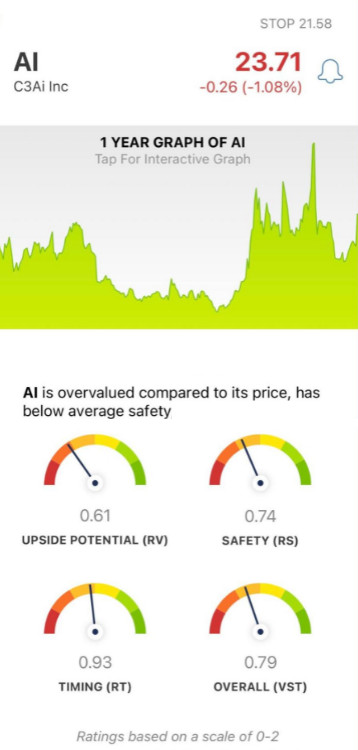20 Best Ideas For Deciding On Ai Investment Advisor Websites
20 Best Ideas For Deciding On Ai Investment Advisor Websites
Blog Article
Top 10 Tips On How To Evaluate The Accuracy And Performance Of Ai Stock Predicting/Analysing Trading Platforms
You need to check the accuracy of AI trading platforms that predict and analyze stock prices. This will assure you are using an accurate tool. These are the 10 most important tips to effectively evaluate these platforms:
1. Backtesting Results
What to look for What to Look For: Make sure the platform offers backtesting features to see how its predictions would have been able to perform on data from the past.
What is the significance of backtesting? Backtesting is a way to verify the validity of an AI model by comparing its predictions with the results of previous tests.
Tip: Choose platforms that allow you to customize the parameters of backtesting (e.g. durations, asset types).
2. Real-time performance tracking
What to watch out for: Check the response of the platform in market conditions that are in real time.
What's important: The real-time performance is a better indicator of the platform's effectiveness than backtesting using historical data alone.
Tip : You can use a demo account, or an evaluation version of the program to monitor real-time movements and compare it to your predictions.
3. Prediction Error Metrics
What to look for Analyze metrics like Mean Absolute Error (MAE), Root Mean Squared Error (RMSE), or R-squared, to measure the accuracy of predictions.
Why it's Important: These metrics give a quantitative measurement of the degree to which predictions are in line with the actual outcomes.
Tips: Platforms that publicly disclose these metrics are generally more transparent and reliable.
4. Rate of Reward and Win Rate
What to look for: Check for the platform's success rate (percentage basing its success on accurate predictions) as well as its percentage of success.
Why is it important: High success rates and win rates indicate better accuracy in predicting and greater potential for profitability.
It is important to be cautious about platforms that make false claims (e.g. 90%, for instance %+),), as there is no way to guarantee that a system will work.
5. Benchmarking Market Indices for Benchmarking
What to watch out for: Check the performance and predictions of the platform against the major market indexes.
Why it is Important It can be used to determine whether a platform is outperforming or underperforming the overall market.
Seek out consistent gains over a long duration of time.
6. Consistency across Market Conditions
What to be looking for What is the performance of the platform in different market conditions.
What is important A solid system will perform well not only under favorable market conditions, but in all other conditions too.
Tips - Test the platform predictions during market conditions that are volatile or when there is a period of low volatility.
7. Transparency in Methodology
What to look for: Understand the AI models and algorithms employed (e.g. neural networks, reinforcement learning).
The reason it's important: Transparency allows you to examine the scientific and technological reliability of a system.
Tips: Stay clear of platforms that use "black box" models without describing how they generate predictions.
8. User Reviews and Tests by Independent Parties
What to watch out for: Read reviews from users as well as independent tests and third-party reviews.
What is important Reviews and tests conducted by independent experts give objective data about the accuracy and performance of the system.
TIP: Go to forums like Reddit, copyright, or financial blogs for reviews of user experiences.
9. Risk-Adjusted Returns
What to Look Out For What to Look For: Assess the platform's performance using risk adjusted indicators such as Sharpe Ratios or Sortino Ratios.
Why it's Important The numbers reflect the amount of risk taken to get the desired returns. They offer a more accurate view of overall performance.
Tips: A high Sharpe Ratio (e.g. higher than 1) suggests higher risk-adjusted return.
10. Long-term Track Record
What to Look for: Evaluate the platform's performance over a time period (e.g. 3-5 years).
What is important Why it matters: Long-term performance is more certainty than short-term outcomes.
Tips: Avoid platforms that show only the short-term or only selective success.
Bonus Tip: Try it with an account that is a demo
You can test predictions made by the platform in real-time without the risk of losing any real money by using a free trial account or demo account. This gives you the opportunity to test accuracy and performance.
These tips will help you determine the accuracy of AI stock-predicting and analysis platforms and choose one that matches your goals in trading and your the risk tolerance. Be aware that no trading platform is perfect, and the best strategy is to blend AI insights with personal analysis. Read the top inciteai.com AI stock app for site info including chatgpt copyright, best ai trading software, ai stock, ai investing, stock market software, best ai etf, free ai trading bot, ai investing, ai stocks, ai trading platform and more.
Top 10 Tips To Evaluate The Risk Management Of Ai Stock Predicting/Analyzing Trading Platforms
Any AI trading platform that predicts or analyzes stocks has to include risk management that is crucial to protecting your capital and limiting losses. A platform that has robust risk management tools can assist you in navigating market volatility and make well-informed choices. Here are ten suggestions to help you analyze the risk management abilities of these platforms.
1. Check out Stop-Loss and Take Profit Features
A level that is customizable: You must be able to modify the take-profit/stop-loss levels of your individual trades and strategies.
Check if you can use trailing stops. These automatically adjust when the market moves towards your advantage.
Guarantees on stop-loss: whether the platform offers stop-loss guarantee, which will guarantee that your account will close at a certain price in even volatile markets.
2. Tools to Measure Positions
Fixed amount - Ensure that you are able to define the size of your positions relative to a specific amount.
Percentage of your portfolio: See whether you can establish size limits in percentages of your portfolio total to control risk in a proportional manner.
Risk-reward ratio: Verify whether the platform can set risk-reward ratios for individual strategies or trades.
3. Check for Diversification support
Multi-asset trade: Make sure that the platform supports trading across multiple asset classes (e.g., stocks, ETFs, options and forex) to diversify your portfolio.
Sector allocation check to determine whether there are any tools that can be used to manage and monitor sector exposure.
Geographic diversification. Verify whether the platform is able to trade on international markets that spread geographical risk.
4. Evaluation of leverage and margin controls
Margin requirements. Be sure to know the margin requirements prior to trading.
Check if your platform allows you to limit leverage to limit risk exposure.
Margin calls: Check if you receive timely messages from the platform to ensure that your account is not liquidated.
5. Assessment and reporting of risk
Risk metrics: Ensure whether the platform has important risk indicators, such as Value at Risk, Sharpe ratio and Drawdown, for your portfolio.
Scenario assessment: Find out whether you are able to simulate different market scenarios on the platform to evaluate possible risks.
Performance reports: Check whether you are able to obtain comprehensive performance reports from the platform, which include the risk-adjusted outcomes.
6. Check for Real-Time Risk Monitoring
Monitoring of portfolios - Make sure that the platform you select has real-time monitoring in order to ensure your portfolio is protected.
Notifications and alerts. Verify whether the platform can provide real-time notification of risk-related events.
Check for customizable dashboards that provide a comprehensive overview of your risk profile.
7. Evaluation of Stress Testing and Backtesting
Stress testing: Make sure that the platform will allow you to stress-test your portfolios or strategies in extreme market conditions.
Backtesting Check if platform supports backtesting with historical data to evaluate risk and performance.
Monte Carlo: Verify the platform's use Monte Carlo-based simulations to evaluate the risk and modeling a range of possible outcomes.
8. Verify Compliance with Risk Management Regulations
Regulation compliance: Ensure that the platform complies with relevant rules for risk management (e.g., MiFID II in Europe, Reg T in the U.S.).
Best execution: Check if the platform is in line with best execution practices, ensuring transactions are executed at the best possible price, minimizing the chance of slippage.
Transparency: See whether the platform offers clear and transparent disclosures about risks.
9. Check for User Controlled Risk Parameters
Custom risk rules: Ensure the platform permits you to define custom risk management rules (e.g. the maximum daily loss, or maximum size of position).
Automated Risk Controls: Find out whether the system is able to automate the enforcement of risk management guidelines based on predefined parameters.
Manual overrides Check whether you are able to manually override the risk control system that is automated in a situation of emergency.
User feedback from reviewers and case research
User reviews: Study feedback from users and evaluate the platform’s efficiency in the management of risk.
Case studies: Search for case studies, or testimonials that show the platform's capability to control risk.
Forums for community members: Find out if there's an active group of traders who share tips and strategies for risk management.
Bonus Tips
Trial period: You can avail a demo or a free trial to try out the risk management features on the platform.
Customer Support: Ensure that the platform is able to provide comprehensive support for any risk management related issues or concerns.
Look for educational sources.
These guidelines will allow you to evaluate the risk management capabilities of AI stock-predicting/analyzing trading platforms. So you can choose a platform which protects your capital and minimizes potential losses. It is vital to use a robust risk management tool in order to successfully navigate volatile markets. Take a look at the most popular updated blog post for stocks ai for more info including ai stock market, investment ai, ai chart analysis, investing ai, trading ai bot, best artificial intelligence stocks, ai stock trading bot free, ai investing app, ai stock picks, stocks ai and more.